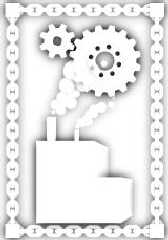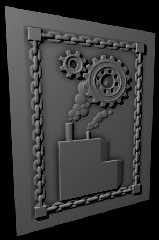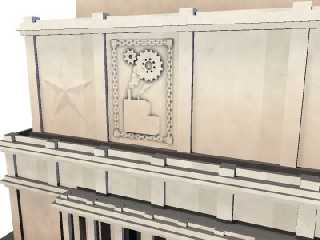 |
 |
|
 |
|
 |
|  |
|  |
|
 |
|
 |
|  |
|  |
|
 |
This technique works very well, but unfortunately is only suited to
imagemaps.
I took my heightfield and blurred a copy, thus rounding the sharp edges. I
then subrtacted the original sharp image from the blurred image using Gimp,
leaving only the blurred regions which were higher than the unblurred. This
resulting image was then inverted, tweaked, and applied to the heightfield
as an imagemap.
The results look great, in my opinion.
The only problem I have is that the resulting texture is an opaque
imagemap, which makes blending it with an onderlying texture a little
tricky. I tried setting it to filter 1.0, but this does not allow the
degree of grime to be adjusted, short of modifying the imagemap itself.
Couple of attached images showing the procedure and results.
-- Simon
Post a reply to this message
Attachments:
Download 'Grime4.jpg' (8 KB)
Download 'Grime1.jpg' (16 KB)
Download 'ReliefCloseup3.jpg' (21 KB)
Preview of image 'Grime4.jpg'

Preview of image 'Grime1.jpg'

Preview of image 'ReliefCloseup3.jpg'

|
 |
|  |
|  |
|
 |
|
 |
|  |
|  |
|
 |
Yes that is it! It make quite a difference and you can do a directional
smear on the grime to show water flow too.
The hand made tech works well, but I wonder if there is a more generalized
shader/texture/pigment based solution?
I guess it would not matter if you could call the GIMP graphics server from
POV code, then even your original depth maps could be code generated as
well as inserted as textures.
Hmmmm.... I wonder if the core GIMP graphics engine could be bolted onto
POV?
Simon de Vet wrote:
> This technique works very well, but unfortunately is only suited to
> imagemaps.
>
> I took my heightfield and blurred a copy, thus rounding the sharp edges. I
> then subrtacted the original sharp image from the blurred image using
> Gimp, leaving only the blurred regions which were higher than the
> unblurred. This resulting image was then inverted, tweaked, and applied to
> the heightfield as an imagemap.
>
> The results look great, in my opinion.
>
> The only problem I have is that the resulting texture is an opaque
> imagemap, which makes blending it with an onderlying texture a little
> tricky. I tried setting it to filter 1.0, but this does not allow the
> degree of grime to be adjusted, short of modifying the imagemap itself.
>
> Couple of attached images showing the procedure and results.
>
> -- Simon
Post a reply to this message
|
 |
|  |
|  |
|
 |
|
 |
|  |
|  |
|
 |
"Simon de Vet" <sde### [at] istar ca> wrote in message
news:Xns### [at] 204 ca> wrote in message
news:Xns### [at] 204 213 213 191 191 226...
> This technique works very well, but unfortunately is only suited to
> imagemaps.
>
> I took my heightfield and blurred a copy, thus rounding the sharp edges. I
> then subrtacted the original sharp image from the blurred image using Gimp,
> leaving only the blurred regions which were higher than the unblurred. This
> resulting image was then inverted, tweaked, and applied to the heightfield
> as an imagemap.
>
> The results look great, in my opinion.
>
> The only problem I have is that the resulting texture is an opaque
> imagemap, which makes blending it with an onderlying texture a little
> tricky. I tried setting it to filter 1.0, but this does not allow the
> degree of grime to be adjusted, short of modifying the imagemap itself.
>
> Couple of attached images showing the procedure and results.
>
> -- Simon
>
Try increasing the canvas size prior to blurring. Increase it enough so the
edges are are white. You will have to calculate new scaling values for the grime
map, but it will help it blend better, as well as give you more room for
creating the water streaks already mentioned. 226...
> This technique works very well, but unfortunately is only suited to
> imagemaps.
>
> I took my heightfield and blurred a copy, thus rounding the sharp edges. I
> then subrtacted the original sharp image from the blurred image using Gimp,
> leaving only the blurred regions which were higher than the unblurred. This
> resulting image was then inverted, tweaked, and applied to the heightfield
> as an imagemap.
>
> The results look great, in my opinion.
>
> The only problem I have is that the resulting texture is an opaque
> imagemap, which makes blending it with an onderlying texture a little
> tricky. I tried setting it to filter 1.0, but this does not allow the
> degree of grime to be adjusted, short of modifying the imagemap itself.
>
> Couple of attached images showing the procedure and results.
>
> -- Simon
>
Try increasing the canvas size prior to blurring. Increase it enough so the
edges are are white. You will have to calculate new scaling values for the grime
map, but it will help it blend better, as well as give you more room for
creating the water streaks already mentioned.
Post a reply to this message
|
 |
|  |
|  |
|
 |
|
 |
|  |
|  |
|
 |
Simon de Vet wrote:
>
> The only problem I have is that the resulting texture is an opaque
> imagemap, which makes blending it with an onderlying texture a little
> tricky.
Put the non invertet map to png alpha channel. Then you can paint
whatever you want on the image as the alpha channel controls the
opacity.
_____________
Kari Kivisalo
Post a reply to this message
|
 |
|  |
|  |
|
 |
|
 |
|  |
|  |
|
 |
I think you should try applying a wind effect going downward to the
blurred version before the subtraction.
--
David Fontaine <dav### [at] faricy net> ICQ 55354965
My raytracing gallery: http://davidf.faricy.net/ net> ICQ 55354965
My raytracing gallery: http://davidf.faricy.net/
Post a reply to this message
|
 |
|  |
|  |
|
 |
|
 |
|  |
|
 |




![]()